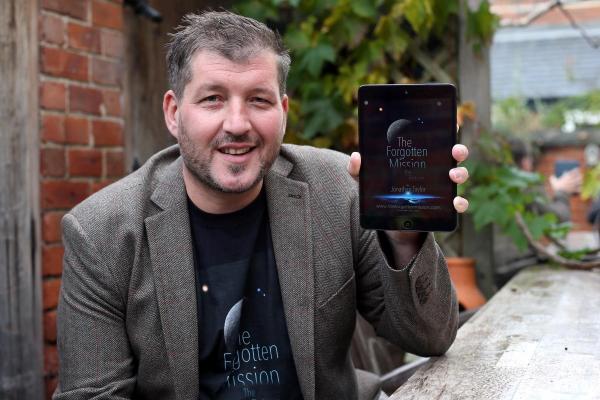I’d written my debut novel whilst going through treatment for cancer, which I was diagnosed with in 2012. The idea, which came whilst on a family holiday to Florida back in 2010, had started to gather dust deep within an app on my iPad. This was the time! I thought. I’d read all the success stories of self-published authors and thought, Right that’s the way I’m going to go. How hard can it be?

While finishing the novel was quite a challenge, it turned out to only be the beginning when self-publishing. What do you do when you have finally completed that amazing journey of writing your book?
Formatting (ebook)
I knew I was going to self-publish it on the Amazon platform KDP (Kindle Direct Publishing) but I needed to learn how. I started looking into how it all worked by watching YouTube clips and reading lots of different articles about how to self-publish. You can search for almost anything on these topics and there’s some great advice out there (be careful though - there's some pretty bad advice too!)
If you do decide to go down the self-publishing route you'll quickly start to find every e-reader seems to work using different formats. So if your finished book is a PDF or Word Doc, you’ll now have the job of re-formatting it into an ePub and then into a Mobi file for it to be uploaded onto the providers platform - so in my case, KDP's platform. There are many programs out there to help you do this. I personally used an excellent program called Calibre. I wrote my whole book on my iPad in the Pages app. I then had to email it to myself so that I could open it in the Calibre program and transfer it to a Mobi file. Calibre also lets you edit the metadata and stores your books in a library in all your desired formats for each e-reader. This did take a bit of getting used to, but it’s pretty straightforward and it really does take the hard work out of uploading it here, there and everywhere. After that though, you just upload your ebook to the platform you want it to become available on, and wait for confirmation that it's live. You're not finished yet though…
Design and formatting (print)
There are lots of people who want to have a paperback in their collection, and I was no different. If you're going to self-publish your work then you've got to be willing to do the work yourself. This means design work, covers etc., and there are loads of apps out there to help you.
I now had the task of designing the paperback. I used Amazon’s CreateSpace, which I found to be absolutely amazing. They have templates which help you design your wrap around cover, and also ones which help the layout of your books' interior.
Now the questions start. What size do you want your book to be? How thick will it be? Don't those sorts of things just happen? The thought hadn't even crossed my mind that I'd need to know the thickness of the spine! Fortunately, the CreateSpace website does help you work it out, and this proved really useful.
Next, I had to download the interior template and open it in my writing app to work out the left and right margins before I could upload my formatted file. Thickness has an effect on a book, and so does your choice of margins: you don't want to break the glued spine trying to read words which are bleeding too far into the inside margin. These are the sorts of things that you don't even think about when you look at a book and it was quite a learning curve!
The future
I am looking at the traditional publishing route at the moment as being represented by a literary agent does open so many doors and I do feel self-publishing can stop you from writing (which is what we authors are best at!). If that doesn't happen though, all things considered I’d definitely self-publish again. Having learnt so much the first time around, I think it'll hopefully be a whole lot easier and allow me to grow as an author.
About the author:
My name is Jonathan Taylor and I live in Darlington, UK, with my lovely wife and two fantastic children. 'The Forgotten Mission: The Return' is my debut novel, and it has been at the #1 chart position on one of amazon.co.uk’s Sci-Fi charts. I’m currently writing the next installment in this series. Please feel free to checkout and connect through the following links:
Website and book links
www.theforgottenmission.com
http://bit.ly/Paperback_com
http://bit.ly/Amazon-com-Link
http://bit.ly/Amazon-co-uk-Link
http://bit.ly/iBookLink
Social media links
www.facebook.com/theforgottenmission
www.facebook.com/AuthorJTaylor
www.twitter.com/Author_JTaylor
https://uk.linkedin.com/in/authorjtaylor
http://bit.ly/EchoArticleNo2
www.Google.com/+theforgottenmissionthereturn
www.tsu.co/AuthorJTaylor
www.theforgottenmission.com
www.Wattpad.com/AuthorJTaylor
www.pinterest.com/forgotmission
www.tumblr.com/forgottenmission
Hi Jonathan Parker, I had read about the Adobe InDesign program, it sounded really good. I might have to take a closer look for next time.
As an alternative, I've recently started using Adobe InDesign - part of the Creative Suite package of design/media programs including Photoshop, Illustrator etc - as the layout program for the text. Although this is a bit more complex (and also more powerful a package) than Calibre, it has the advantage of eliminating the need to transfer the finished document to a separate Mobi file. This is achieved by using 1 of 2 inbuilt plugins. InDesign already comes complete with an option to Export to the Epub format - which allows you to publish directly to all ebook formats except for the Kindle (which is what the Mobi format is designed for as far as I know). A separate free plugin available from Amazon - www.amazon.com/kindlepublishing - adds a second option to the InDesign file format menu called 'Export for Kindle' which will automatically convert your text to a specifically Kindle-compatible format without the need for any further file conversion.